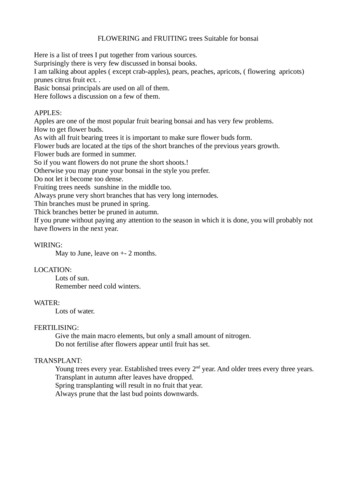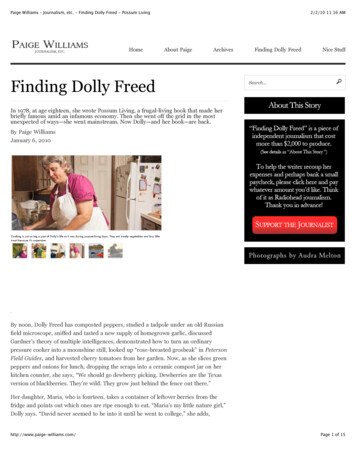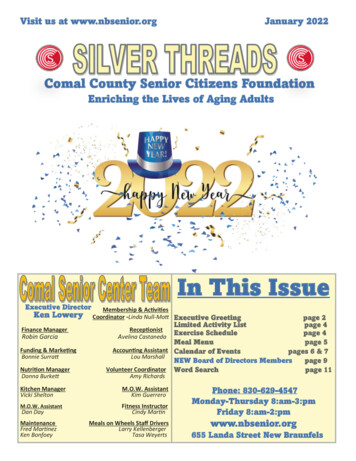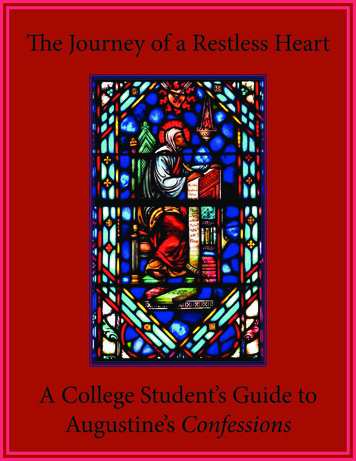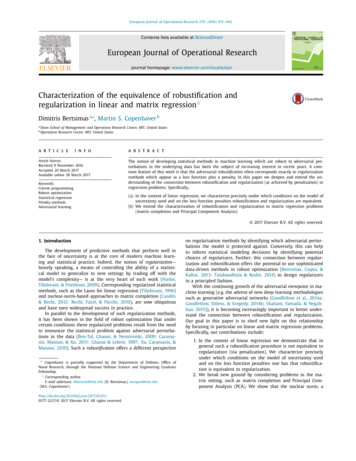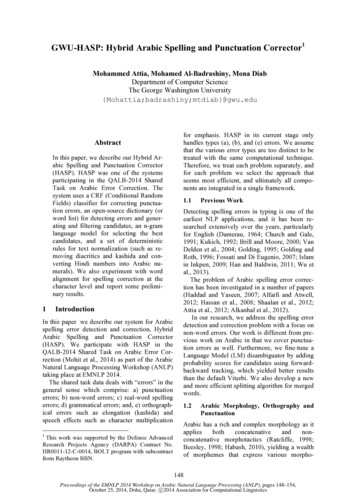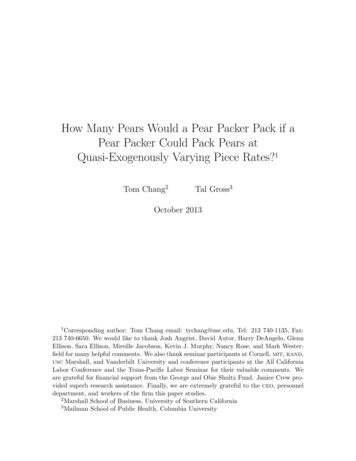
Transcription
How Many Pears Would a Pear Packer Pack if aPear Packer Could Pack Pears atQuasi-Exogenously Varying Piece Rates?1Tom Chang2Tal Gross3October 20131 Correspondingauthor: Tom Chang email: tychang@usc.edu, Tel: 213 740-1135, Fax:213 740-6650. We would like to thank Josh Angrist, David Autor, Harry DeAngelo, GlennEllison, Sara Ellison, Mireille Jacobson, Kevin J. Murphy, Nancy Rose, and Mark Westerfield for many helpful comments. We also thank seminar participants at Cornell, mit, rand,usc Marshall, and Vanderbilt University and conference participants at the All CaliforniaLabor Conference and the Trans-Pacific Labor Seminar for their valuable comments. Weare grateful for financial support from the George and Obie Shultz Fund. Janice Crew provided superb research assistance. Finally, we are extremely grateful to the ceo, personneldepartment, and workers of the firm this paper studies.2 Marshall School of Business, University of Southern California3 Mailman School of Public Health, Columbia University
AbstractWe examine labor supply using a unique dataset collected from a large pear-packingfactory. Pear packers face both expected and unexpected shocks to their wages, andwe use this to evaluate different models of inter-temporal labor supply. We find strongevidence for reference-dependent preferences, but only mixed support for models ofrational-expectations-based targets.
1IntroductionThe way in which workers respond to a change in their wage rate is of interest toboth academics and policy makers. Understanding how workers respond to wagechanges determines the optimal incentive scheme that employers ought to provide(Prendergast, 1999). Moreover, the evaluation of government tax and transfer programs depends crucially on reliable estimates of how labor supply responds to wages(Farber, 2008).In the absence of income effects, the neoclassical model of labor supply predictsa positive wage elasticity of work. But starting with work by Camerer et al. (1997),several empirical studies have challenged this prediction. Instead, they find evidenceof negative temporal substitution in response to temporary wage shocks. Individualsseem to work less hard when their wages rise. These studies have suggested a modelbased on prospect theory, a model that combines neoclassical preferences with areference point and loss aversion.1 In such models, individuals are assumed to bemore sensitive to changes in income below some reference point than above it. Thiscreates a kink in preferences around the reference point that can lead to a negativewage elasticity, even in the absence of income effects.Such models have inspired a number of empirical studies, but the importanceof reference-dependent preferences in labor supply is still unclear. The literatureon reference-dependent labor supply has focused exclusively on the labor supply ofworkers that are free to set their own hours.2 It remains unclear whether referencedependent preferences are an important factor in determining the labor supply ofworkers who work in an hours-constrained environment.1See, for instance, Kahneman and Tversky (1979) and Tversky and Kahneman (1991).For instance, economists have studied the behavior of cab drivers (Camerer et al., 1997; Chou,2000; Farber, 2005, 2008; Crawford and Meng, 2008), stadium vendors (Oettinger, 1999), bicyclemessengers (Fehr and Götte, 2007), and fishermen (Giné et al., 2010).2
This paper adds to this literature in three ways. First, we examine worker behaviorin a setting where workers cannot choose their own hours, but can adjust their effort.Since relatively few professions allow workers to freely set their own hours, suchan environment may be more representative of the general workforce. Second, thedata we study allow us to explicitly test the role of cumulative worker fatigue indetermining the labor supply of our workers. Third, we examine the role of bothskill and experience in determining how workers respond to both predictable andunpredictable shocks. To our knowledge this paper is the first to examine referencedependence in an hours-constrained environment, and the first to measure the effectof fatigue (increasing disutility of effort) in downward-sloping labor supply.We analyze how workers respond to changes in their wage rate using a dataset ofworkers at a California firm that packages pears and ships them to retailers. We usea combination of worker-day-level payroll data as well as worker-minute-level datafrom a field-collection effort. The workers in this firm regularly face both expectedand unexpected shocks to their wages, and we examine the workers’ response to theseshocks to directly test several models of labor supply.The workers in our sample face two types of wage shocks. The first wage shock isdriven by state laws regarding overtime. Workers are required to stay for an entireshift, but the length of a shift varies. Once a worker has worked eight hours in agiven day or forty hours in a given week, the firm must increase compensation byfifty percent. Workers do not know the exact length of a shift on any given day, thusdaily overtime represents a partially unexpected shock to wages. In contrast, weeklyovertime is much more predictable, and represents a largely expected shock to wages.The second type of wage shock is driven by the way work is organized on thefactory floor. As workers package pears for shipping, they rotate across bins filledwith pears of different sizes. Workers must pack a different number of pears into each2
box, depending on the size of the pear at their current bin. But workers are paid thesame piece rate for each box packed. As such, when packing larger pears, a worker’simplicit wage rises, because fewer pears need to be packed per box. Conversely, whenassigned to pack smaller pears, their implicit wage falls. For the sake of fairness,the workers rotate across bins, spending roughly fifteen minutes at each bin. As aresult, variation in pear size generates high-frequency, predictable variation in wagesthroughout the course of a workday.Our empirical analysis leads to three main findings. First, workers respond tounexpected overtime by decreasing their effort. Second, workers respond to expectedovertime by increasing effort, and this increase is larger for more experienced workers. Third, workers respond to bin rotation in a manner that differs by their skilllevel.3 While the average worker responds by decreasing effort when facing a higherimplicit wage, skilled workers respond with increasing levels of effort. The changesin effort we estimate are consistent with reference-dependent preferences, and suggest that reference dependence may be an important factor in the labor supply ofhours-constrained workers. Specifically, we find that workers respond to overtime ina manner consistent with the work of Köszegi and Rabin (2006), and their modelof reference-dependence based on rational expectations.4 That is, workers exert lesseffort during overtime when that overtime is unexpected, even though it correspondsto a 50-percent increase in piece rates.In contrast, the wage elasticity we estimate based on workers rotating across pearsof different sizes depends on each worker’s skill. Unskilled workers exhibit a negativewage elasticity when rotating across pears of different sizes, but skilled workers exhibit3As described below, we measure the skill of each worker with their average packing speed.Köszegi and Rabin (2006) present a prospect-theory value function with a reference point determined by expectations. These expectations need not be “fully rational,” but could be replacedby “any theory of how these expectations are formed.” Following Köszegi and Rabin (2006), “as adisciplined and largely realistic first pass,” we assume that expectations are fully rational throughoutthe paper.43
a positive wage elasticity. Since these wage changes are predictable, this finding isconsistent with rational-expectations-based targeting, but only for skilled workers.For unskilled workers, these results are consistent with neither a neoclassical modelof labor supply nor rational-expectations-based targeting.These findings paint a complex picture of how workers respond to wage changes.While workers appear to have reference-dependent preferences, learning or skill seemsto be an important factor. While all workers respond to both expected and unexpected overtime in a manner that is consistent with rational-expectations-based dailytargets, the difference in response to overtime predictability is markedly bigger formore experienced workers. In addition, in response to the fully predictable changesin wage associated with rotation across packing stations, only skilled workers exhibitbehave in a manner consistent with the neoclassical model.5 Our results are thus supportive of Köszegi and Rabin (2006) as well as the idea that experience can reduceor eliminate some observed behavior biases as in List (2011).The paper is organized as follows. The subsequent section provides a brief reviewof the literature on labor supply and describes our contribution to that literature.Section 3 describes the pear-packing factory and the wage shocks experienced by theworkers. Section 4 reviews the different labor-supply models and their implicationsin this context. Section 5 presents estimates of how workers react to wage changesdriven by pear size, and section 6 presents empirical estimates of how workers reactto wage changes driven by overtime. Section 7 concludes.5And thus also consistent with rational-expectations based targets, since the two models generateidentical predictions in a setting with no unexpected shocks.4
2Previous Research on Reference-Dependent Labor SupplyThis paper contributes to a growing literature on the importance of reference-dependentpreferences in labor supply. We focus on workers who do not control their schedulesbut do control their effort. In contrast, previous studies have focused on workers inoccupations with flexible hours. Camerer et al. (1997), for instance, study the behavior of New York City cab drivers. The authors use the average daily wage of otherdrivers as an instrument for each driver’s wage. They find that drivers work fewerhours when average wages are higher, a result consistent with reference-dependentpreferences. Chou (2000) finds similar evidence among taxi drivers in Singapore.Fehr and Götte (2007) run a field experiment on bicycle messengers and find thathigher wages have a positive effect on the number of hours worked, but a negativeeffect on effort per hour. The authors argue that effort, and not hours, is the moreaccurate measure of labor in their setting and so conclude that workers have referencedependent preferences.Other studies have not only documented reference-dependent preferences, buthave tested how reference points are determined.6Farber (2005, 2008), for in-stance, calibrates a model of New York city cab drivers which incorporates a keydistinction between unexpected and expected wages. He finds mixed evidence forreference-dependent preferences; drivers’ stopping probabilities are significantly related to hours but not earnings. Crawford and Meng (2008) use Farber’s data toestimate a model of reference-dependent preferences, and find strong support forrational-expectations-based targets. Similarly, Giné et al. (2010) find support fora model of reference-dependent preferences with rational-expectations-based targetsamong fishermen. And in a recent lab experiment, Abeler et al. (2011) directly ma6In addition, there exist studies that focus on reference dependence in contexts other than laborsupply (Pope and Schweitzer, 2011).5
nipulate the expectations of their subjects and finds that effort provision varies in away consistent with rational-expectations-based targets.In contrast, other studies have found results consistent with the neoclassical modelof labor supply. Oettinger (1999) finds that stadium vendors are more likely to workon days when they can expect a higher wage, while Paarsch and Shearer (1999)measure a positive relationship between piece rate and productivity among workersat a tree-planting firm.7 Similarly, Lazear (2000) finds that workers respond to aswitch from fixed wages to piece rates by increasing effort.A common characteristic of past studies is their focus on settings where workersare free to set their own hours.8 The literature focuses on how the decision to stopworking is affected by wage and hours targets. In contrast, the workers in our samplecan neither choose what days to work nor how long to work on any given day. Insteadthey must attend all shifts and stay for the entirety of the shift length. Since mostworkers are not free to set their own hours, our findings extend this literature into animportant segment of the labor market.In addition, our data allow us to explicitly test for the role of cumulative fatigue(both within and across days), as well as worker skill and experience, in determininglabor supply. Importantly, we are able to test whether fatigue drives the downwardsloping labor supply that much of the targeting literature has documented.9Finally, we build on the work of Crawford and Meng (2008) by examining therelative importance of different reference points (e.g. daily hours, hourly rate) on7Since the changes in wage studied by both Oettinger (1999) Paarsch and Shearer (1999) areanticipated by workers, their results are also consistent with reference-dependent preferences withrational-expectations-based targets.8An exception is a paper by Dickinson (1999). In a laboratory experiment, the author findsthat when hours are constrained, worker effort is positively correlated with wage. When subjectsare allowed to set their own hours, however, some respond to higher wages by working longer butexerting less effort. Gill and Prowse (2012) also study a related laboratory experiment involving asimulated labor market and loss aversion.9For example, while Camerer et al. (1997) argue that New York City cab drivers do not tire fasteron high-wage days, they do not provide empirical evidence to support this position.6
a worker’s labor supply. Our data allow us to measure a worker’s response to threedifferent shocks to wages, an important source of variation that reveals that individualworkers may simultaneously utilize different methods to set their reference points fordifferent parameters.3How Pears are PackedWe examine the behavior of workers who package pears to be shipped to market at alarge pear-packing facility in California. Due to the nature of the work, pear packersat the factory face both expected and unexpected shocks to implicit wages. Thissection describes how those shocks arise.Because of their thin skin, pears do not respond well to bulk shipping. As a result,packers must wrap each pear individually in tissue paper and carefully arrange thepears in boxes. The procedure is labor intensive and must be done by hand. Butsuch packaging allows the firm to ship pears directly to retail outlets and preservethe value of the fruit in transit.Pears arrive at the factory each morning from farms throughout northern California. Once washed, the pears pass through a quality control process in which damagedpears are removed. The remaining pears then travel along a conveyor system thatsorts the pears according to size into large rotating bins. Following industry standards, the pears are sorted into the following sizes: 60, 70, 80, 90, 100, 110, 120,135, 150. The size of each pear indicates the number of pears that will fit into astandard, four-fifth-bushel box. For example, 100 “size 100” pears would be packedinto a standard box.Packers individually wrap and then carefully arrange pears in large cardboardboxes according to a pre-determined pattern based on pear size. Once a box isfinished, the worker places the box on a conveyor belt that takes the box to a station7
where it is placed onto a pallet for shipping. A random subset of boxes is inspectedto ensure that workers have taken sufficient care in packing each box. If a box isfound deficient, the worker receives a lower piece rate for all boxes packed that day.Such fines are extremely uncommon in our data, with the median number of fines perworker-year equal to zero.Packers are paid the same piece rate for each box regardless of the number of pearsit contains. Workers thus face a higher implicit wage when packing larger pears. Forinstance, while a worker must exert fifty percent more effort to fill a box with 120 smallpears than with 80 large ones, the worker will be paid the same piece rate for bothboxes.10 For that reason, the firm requires packers to rotate across packing stations,so that each worker spends the same amount of time with each pear size. Typically,workers spend fifteen minutes at each station and then switch to the next-larger size.When they reach the end of the line, the workers switch back to the station with thesmallest pears. If a worker is part way through a box when it is time to rotate, theworker finishes the box before moving to the next bin. The bins are large enough thattwo workers can have simultaneous, unrestricted access to a single bin. Standard pearsizes vary from 70 to 150, so the number of pears that must be packed in a standardbox varies by more than a factor of two. Thus a worker will experience a changein piece rate at regular intervals (every fifteen minutes) throughout each shift. If aworker’s piece rate earnings for a single day implied a wage lower than the Californiaminimum wage, then the worker was paid minimum wage.11In addition, the firm provides packers with overtime pay in accordance with California law. Packers received overtime wages when they had been working for more10The pears weigh very little, approximately 4–6 ounces. Thus the physical effort required to packa single pear does not vary by size.11In general, the minimum wage constraint applied only to new workers as they learned to pack,and affects only a small fraction of our sample. All empirical results are unaffected by removingsuch ‘hourly’ days from our sample.8
than 8 hours in any given day or for more than 40 hours in any given week. Wagesincreased by 50 percent when the overtime limits were reached. For example in 1990,overtime increased a worker’s piece rates from 43 cents to 64.5 cents a box.12 Packersgenerally work 6 days per week, Monday through Saturday, and are expected to workfor an entire shift, regardless of the work day’s duration.The “just-in-time” nature of pear packing leads to significant daily variation inshift length. Given limited cold storage space, pears at the plant are generally packedwithin 24 hours of being picked. Figure 1 plots the daily shift lengths over the2002 season, and demonstrates that the variance in hours is large. This subjects theplant’s daily production to fluctuations both due to supply and demand. Demandfrom individual retailers can vary in response to idiosyncratic sales conditions, whilethe supply of pears to be packed on a given day is affected by the productivity offarms currently being harvested.In summary, pear packers are subject to several wage changes. The first is causedby variation in pear size; the packers’ implicit wage changes every fifteen minutes.Second, packers’ wages change when overtime begins. In particular, overtime leadsto two types of wage shocks. Early in the week, a worker will receive overtimepay for any work done after the eight-hour mark. Workers arrive each day with noknowledge of the length of that day’s shift.13 As such, daily overtime represents apartially unexpected, fifty percent increase in wages. Towards the end of the week, the40-hour-a-week overtime constraint will bind. Weekly overtime is highly predictable.For example, if workers have put in a total of 38 hours from Monday through Friday,then they know that when they come in Saturday morning, overtime will begin after2 hours. Thus weekly overtime represents a largely expected 50 percent increase in12One of the authors, Chang, worked as a pear packer in 1990 and 1991.During lunch, some workers may ask the shift supervisor whether the work day will last intoovertime. But often the supervisor may not know.139
wage.We collected two types of data at the firm. First, the firm’s personnel departmentprovided payroll records for the 2001, 2002, and part of the 2003 packing seasons.For each season, the payroll data list each worker’s total boxes packed during regularhours, total boxes packed during overtime, regular hours worked, and overtime hoursworked.14 Turnover among workers is high; roughly 70 percent of workers in one yeardid not return the next year.The payroll data do not indicate the size of the pears packed in each box, becausesuch information is not relevant to the workers’ pay. As such, we cannot use thepayroll data to examine how workers respond to the high-frequency wage changesassociated with rotating from one bin to another.For that reason, we collected data on output for a small set of workers on thefactory floor during the summer of 2007. A research assistant monitored workersalong one production line (row of bins) and recorded the time each worker spentpacking each box. Over the course of four weeks, the research assistant measuredthe output of workers for 20 shifts; this generated data on 3,967 boxes packed by 70packers.154Models of Labor SupplyThis section presents a simple model of a worker’s labor supply decision to illustratethe response of workers with neoclassical and reference-dependent preferences in thecontext of pear packing.14Workers were given unique employee identifiers for each calendar year, but those identifiers arenot unique across years. For that reason, we linked workers across years based on their full names.15We had hoped to collect payroll data on the same workers as in the on-site sample. Unfortunately,the factory has closed, and we were unable to procure that data.10
4.1Basic ModelAn agent can work for up to two periods, and must choose her effort at the start ofeach period. The worker’s expected utility at the start of period 1 is: 11 22E [u(e1 , e2 )] e1 e1 ρ · ωe2 (e2 γe1 ) .22(1)In this utility function, et represents the effort exerted in period t and ω representsthe ratio of period-1 wages to period-2 wages. The parameter ρ [0, 1] represents theworkers’ belief that work will continue into period 2. The parameter γ 0 representscumulative fatigue, whereby effort exerted in period 1 increases the dis-utility of effortin period 2.Consider the wage shocks experienced by pear packers. First, consider the caseof a worker rotating across bins containing different sizes of pears. Each period inequation (1) then represents the 15 minutes spent at each particular bin. In thissetting, packers expect period 2 to occur (ρ 1), fatigue should have little effectacross such short time periods (γ 0), and ω is equal to the ratio of implicit wagesdriven by the difference pear sizes in the two bins.Next, consider the effect of overtime. Here we treat regular hours as period 1 andovertime hours as period 2. The parameter ρ then captures whether or not overtimeis expected, and ω 1.5. In our setting, weekly overtime is largely expected, butdaily overtime is only partially predictable. In our empirical analysis we utilize aninstrumental variables technique similar to that of Crawford and Meng (2008) toseparately identify predictable daily overtime from unpredictable daily overtime.11
4.2Neoclassical PreferencesAt the start of period 1, the worker’s expected utility is given by equation (1) above,and worker utility at the start of period 2 is:E [u(e1 , e2 )] ωe2 1(e2 γe1 )2 .2(2)Workers with neoclassical preferences choose effort by maximizing equations (1) and(2). Their optimal effort is thus(e 1 , e 2 ) (1 ρωγ, ω γe 1 ) (1 ρωγ, ω γ(1 ρωγ)) .(3)First, consider packer response to bin rotation. Since period 2 is expected (ρ 1)and fatigue is not a significant factor (γ 0), equation (3) implies that e 2 /e 1 ω.That is, when period 2 is expected and the effect of fatigue is negligible, then workers’effort in each period is proportional to their wage.Second, consider the case of overtime. In this case, period one represents eighthours of work, and thus fatigue is potentially an important factor (γ 0). In addition,the likelihood of overtime (period 2) occurring is uncertain.When period 2 is expected (workers expect overtime), ρ 1, and equation (3)implies that e 2 e 1 if and only if ω 1 γ.1 γ γ 2In such a case, workers will exhibita positive wage elasticity for any ω 1. In contrast, when overtime is completelyunexpected (ρ 0), e 2 e 1 if and only if ω 1 γ.Note that since1 γ1 γ γ 2 1 γ for all γ 0, there exist a set of wage and fatigueparameters (ω, γ) such that workers will exhibit a positive wage elasticity in responseto overtime when overtime is anticipated, but a negative wage elasticity when overtimeis unanticipated. Thus, neoclassical preferences can generate behavior consistent with12
reference-dependent preferences (described below).16Specifically for values of ω and γ that satisfy the condition ω 1 γ,1 γ γ 2workerswill always exhibit a positive wage elasticity with respect to overtime pay regardless of 1 γwhether it is anticipated or not. In contrast, for values of ω 1 γ γ,1 γworkers2will exhibit a positive wage elasticity when overtime is expected, but a negative wageelasticity when overtime is completely unexpected.Intuitively, consider the case when overtime comes as a surprise. In that case, aworker may exert a great deal of effort in period 1 without regard for the deleteriouseffects period 1 effort has on period 2 effort. Then, when overtime arrives, they mayexert less effort due to exhaustion, even though the wage rate is higher. In this sense,a negative wage elasticity with response to overtime alone is not evidence that workersare irrational.Nevertheless, since wages increase a great deal during overtime (ω 1.5), fatiguewould have to be an extremely large factor to generate negative wage elasticities.Such a possibility though should not be ruled out a priori, but rather ruled out bythe data.Fortunately, the model provides a test of the extent to which unexpected shocksaffect labor supply. Worker effort in period 1 should decrease as the probability ofovertime increases ( e 1 / ρ 0). That is, if fatigue is a factor, when workers expectovertime, they should exert less effort during regular time to save their strength forthe more lucrative overtime period. The results of such a test are presented in Section6.16See Camerer et al. (1997) for a discussion of the fatigue hypothesis as potential source of theobserved negative wage elasticities in cab drivers.13
4.3Reference-Dependent PreferencesModels of targeting assume that workers choose a level of some parameter as a goal,beyond which they become less responsive to changes in their wage. That is, theirpreferences depend on some target or reference level. For example, according tomodels of daily income targeting, workers hold a specific dollar value as a daily targetincome level. Under this model, workers may work less when their wage is higher,because the higher wage allows them to reach their income targets more quickly.Following Köszegi and Rabin (2006), we incorporate reference dependence intoour model by adding an additional term to the agent’s utility function.17 Equation(1) becomes: v e1 , e2 ; y R u (e1 , e2 ) I yt ytR · λ · [e1 ωe2 ] .(4)Here, y is the value of a target variable, y R is its target value, and λ 0 representsthe relative importance of the “gain-loss utility” that captures the behavioral biasbrought about by exceeding the target level. In this context, yt is the number ofhours that a packer has worked in a day, and y R is the number of hours they expectto work. We discuss this further, below.A challenge for researchers in this area is determining which parameters are targeted (e.g. daily hours, weekly income, hourly rate), and how the targets are set (e.g.heuristics, rational expectations). For example, taxicab drivers may have a dailyhours target, while a ceo might have a quarterly earnings target. Knowing whatparameters are targeted, and how those targets are set, is central to measuring the17In the general Köszegi and Rabin (2006) model, there would be a third term associated with thegain-loss utility that occurs if workers expect to work longer than they do. While this third termwould affect worker utility, since workers cannot set their own hours, we are able to exclude it fromequation (4) as it affects worker preferences only in situations in which there is no observed workereffort.14
impact (if any) of reference-dependent preferences.Following Köszegi and Rabin (2006), we model targets as set equal to the agents’rational expectations: y R E(y). This implies that changes in the target variablemust be unanticipated to generate behavior that differs from the neoclassical model.Packers will thus only deviate from the neoclassical model when events are unanticipated. For example, if packers can perfectly anticipate the length of a shift, y y R ,then the gain-loss term drops out of their utility function and does not affect theirdecisions. In contrast, if workers set targets by some other means, then even fullyanticipated changes may affect decisions. We refer to such targets as heuristics-based.Consider then the case of a packer rotating from one bin to another (ρ 1 andγ 0). Workers can perfectly anticipate the move to the next bin. Thus if workers settheir targets via rational expectations, the preferences above mirror the neoclassicalcase. If, on the other hand, workers’ targets are not set via rational expectations, thentheir response to changes in their implicit piece rate can differ from the neoclassicalc
1Corresponding author: Tom Chang email: tychang@usc.edu, Tel: 213 740-1135, Fax: 213 740-6650. We would like to thank Josh Angrist, David Autor, Harry DeAngelo, Glenn . throughout the course of a workday. Our empirical analysis leads to three main ndings. First, workers respond to unexpected overtime by decreasing their e ort. Second, workers .

